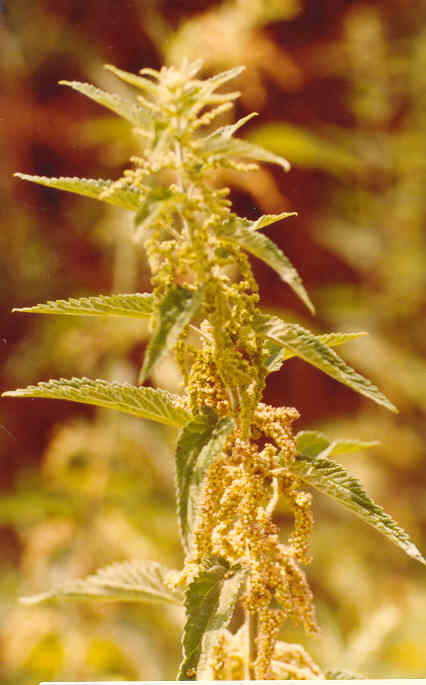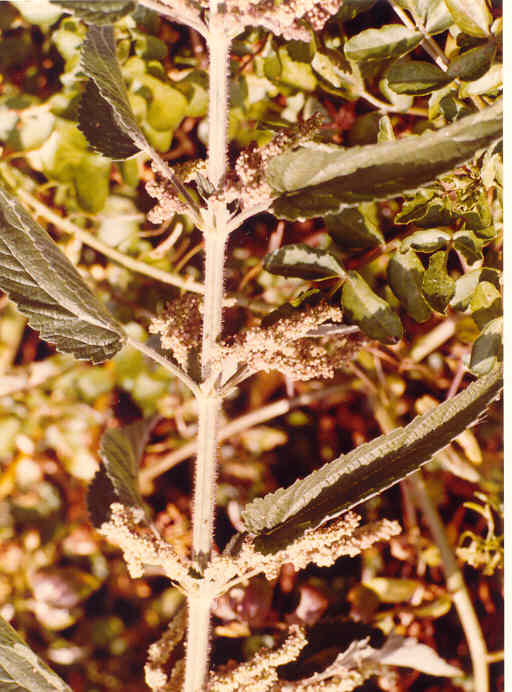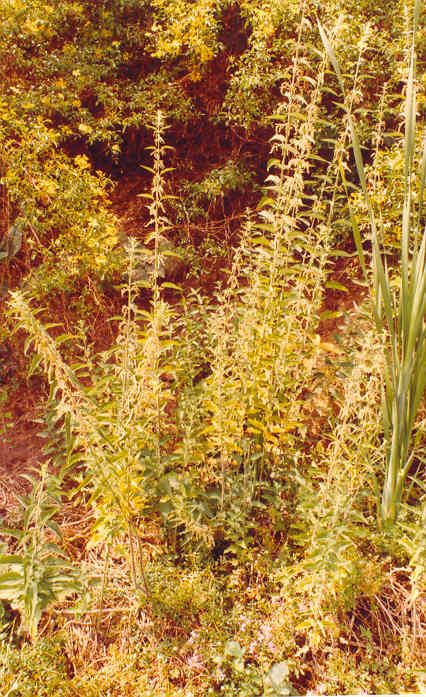
Urtica dioica ssp. holosericea (Nutt.) Thorne
=Urtica holosericea
=Urtica gracilis var. holosericea
Urticaceae (Nettle Family)
Native
Creek Nettle
Hoary Nettle
 |
Urtica dioica ssp. holosericea (Nutt.) Thorne=Urtica holosericea=Urtica gracilis var. holosericea
Urticaceae (Nettle Family)NativeCreek NettleHoary Nettle
|
June Photo
Plant Characteristics:
Perennial from underground rootstocks, the stems rather stout and simple,
1-2.5 m. tall, bristly, and also densely fine-pubescent; stems and lower lf.
surface with moderate to dense nonstinging hairs; lvs. lanceolate to
narrow-ovate, 5-12 cm. long, coarsely serrate, densely soft-pubescent and
grayish beneath, greener above, attenuate at apex, on petioles 1-4.5 cm. long;
stipules narrow-oblong, 5-10 mm. long; male clusters rather loose, almost as
long as the lvs.; female denser and shorter; fls. ca. 1 mm. long; ak. broadly
ovate, smooth. There is no description as to
which hairs of this species are stinging. Robbins,
et al. says the stems of U.
urens have sparse stinging hairs and that the leaves bear scattered stinging
hairs. (my comments).
Habitat:
Low damp places, below 9000 ft., many Plant Communities; cismontane
Calif.; to Wash., Ida.; occasional on desert edge; Santa Catalina and Santa Cruz
Ids. Bloom period not listed in
Munz. Bloom photographed in June.
(my comments)
Name:
Latin, urere, to burn. (Munz,
Flora So. Calif. 847). Refers
to the stinging hairs. (Hickman,
Ed. 1083). Greek, holos,
whole, and Latin, ser, silk. (Jaeger
119,236). I do not see the
relationship between the plant and the species name holosericea unless it
refers to the abundant pubescence on the stems and leaves. (my comment). Dioica, means "two dwellings", referring to
the fact that the male and female flowers are usually on separate plants.
(Hatfield 132).
General:
Common in the study area. Common
in big canyon and along Back Bay Dr. at the northerly end of Eastbluff.
Photographed at the northerly end of Eastbluff.
(my comments). Nettle leaves were used by Indians
for a raw vegetable or boiled as greens. Stem
fibres were used to make bowstrings and in basket making.
Nettles were applied to various aching areas such as a rheumatic leg or
arm. Boiled roots were used
in early Europe to obtain a yellow dye. Nettle
contains formic acid and this is the stinging material-the same as some ants.
Partly due to its high nitrogen content, the nettle is an active
decomposer and humus maker and if often used as a catalyst to ferment compost
heaps by commercial houses that sell purely organic fertilizer.
Nettle plants are reportedly used as a food source by the Brown Towhee.
(Clarke 161).
The plant
has
been used as a treatment for rheumatism by using bundles of fresh nettles
as whips to beat the affected part; the pain of the nettles and possibly the
acid injections, covering up, if not curing the rheumatism.
For many years, the seeds were used to treat consumption.
(Coon 217).
Fibres of the genus were used by the Gabrielanos to make string and
cordage. The fibre strands were
rolled on the thigh. Both sexes joined in this occupation. The strings were rolled into two and four ply, possibly 3 ply
as well and rope was formed of several strands of two-ply string.
Gabrielanos would sting themselves, particularly on the eyelids before a
hunt for large game. A sort of
ritual reminder to the men that they really possess the power and courage to
carry out the expedition with success. (Johnston 34-35). This nettle's flowers are the only
food of the caterpillars of the lovely peacock butterfly and the equally
exquisite tortoise shell butterfly. A
complete plant-food liquid can be made by soaking a sheaf of nettles in a vessel
of rainwater for two or three weeks. At
the end of that time, the water will contain all the plant's virtues.
A liquid fertilizer made from nettles, either fresh or dried, is not only
a good folia feed, but also an effective spray against mildew, black fly, aphis,
and plant lice. When it becomes
necessary to handle these nettles, grasp the hairs in such a way that they are
pressed back into the stem. Then
the plant will not be able to sting you. Although
the stinging nettle is common from Maine to Minnesota, and as far south as
Missouri, Americans seldom eat them. In Europe, however, they have been used for food and drink
for centuries. So valued were they
as a potherb and vegetable and for the tingling flavor they add to homemade
teas, wines, and beers-that they were at one time cultivated in most European
gardens. (Hatfield 132-136).
The Cahuilla, Indians of the Colorado Desert, the San Jacinto, and San
Bernardino Mountains, used U. holosericea for "stiff feet".
Nettles were placed on the feet and wrapped in cloth.
Nettle fibre was used to make bowstrings and in basket making. (Bean and
Saubel 143). Delfina
Cuero, a Kumeyaay or Southern Diegueno Indian, made the following comments about
Urtica holosericea in her autobiography:
"Formerly we gathered and boiled for greens.
We also cooked a lot to a real strong liquid and bathed in it when we got
into poison oak, and also for skin diseases."
Shipek 98).
Astringent and diuretic. The
tea can be used for internal bleeding, such as excessive menstruation,
nosebleeds, and capillary bleeding from heavy coughing and vomiting.
(Moore, Medicinal Plants of the Mountain West 114).
Nettle tea is one of the oldest countryside beverages of England,
believed to have been introduced by the Roman invaders.
(Meyer 173). Presumably Meyer is referring to species
from the family Urticaceae, as he gives no Latin name.
(my comment).
Nettle tea is an excellent hair tonic and will bring back the natural
color of the hair. Use as the last
rinse when shampooing. (Kloss 289).
Urtica dioica (nettle roots).
Also known as stinging nettle, has been studied for its therapeutic
effect on "prostatic ailments" for quite some time.
Japanese pharmacologists suggested that a "steroid in the stinging
nettle roots" may "suppress prostate-cell metabolism and growth."
In a study conducted by Tadeusz Krezeski et al (1993), 134 participants
reported a significant decrease in frequent night urinations and in residual
urine. The subjects took 600 mg/day
of Urtica dioica root extract, combined with 50 mg/day of Pygeum
africanum bark extract. (Yutsis, Pavel, M.D. "The Tiny Prostate Can Cause Big
Trouble", Journal of Longevity Research, Vol. 3 No. 3, 1997 pp.
15,16). Some
species are capable of providing a good strong white linen.
(James 52).
The sting from stinging nettle, ants and bees is acidic.
You can often relieve the pain by quickly applying an alkaline substance
to the area involved. Some of the
more readily available alkaline compounds are bicarbonate of soda and soap. Wasp
stings are alkaline in nature. (Williams,
David G, “Insect Stings—Acidic or Alkaline?”
Alternatives for the Health-Conscious Individual Volume 8, No 18
December 2000 p.143).
In a double blind study published in Planta Medica, people with
allergic rhinitis (hay fever) who were given a freeze-dried stinging nettle
extract for one week noticed a much greater improvement in symptoms than those
who were given a placebo. Stinging
nettle, Urtica dioica, seems to work by blocking the formation of
inflammatory chemicals, likely due to the histamine found in its leaves. Author
Unknown, “Itch Weed Brings Relief” Health & Healing Volume 11,
No. 10, p4. October 2001.
About 30
species in wide distribution. (Munz,
Flora So. Calif. 847).
Text Ref:
Abrams, Vol. I 524; Hickman, Ed. 1083; Munz, Calif. Flora 920;
Munz, Flora So. Calif. 847; Robbins et al. 128.
Photo Ref:
June 7 83 # 8A,9A,10A.
Identity: by R. De Ruff.
First Found: June 1983.
Computer Ref: Plant Data 291.
No plant specimen.
Last edit 11/13/04
 |
 |
. June Photo June Photo